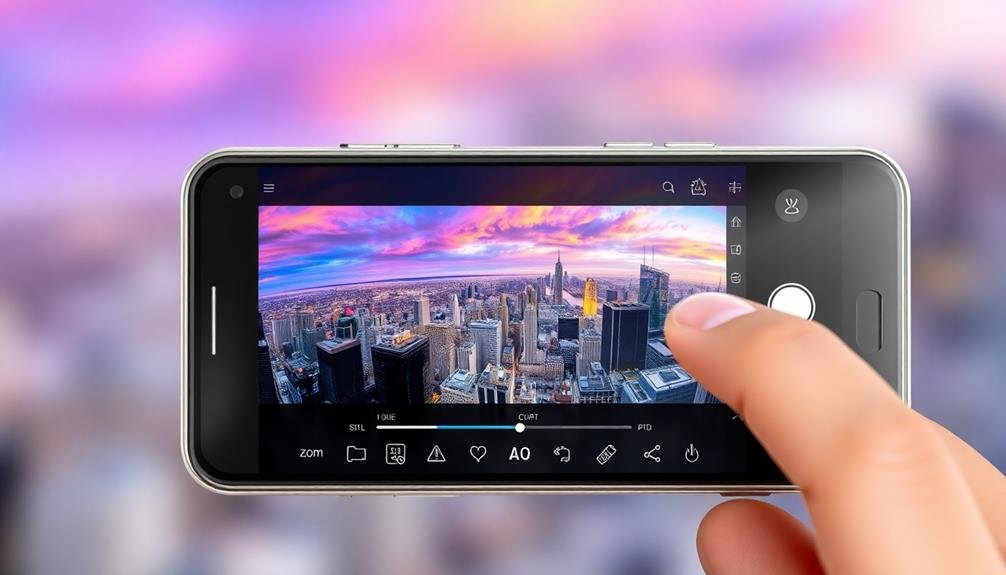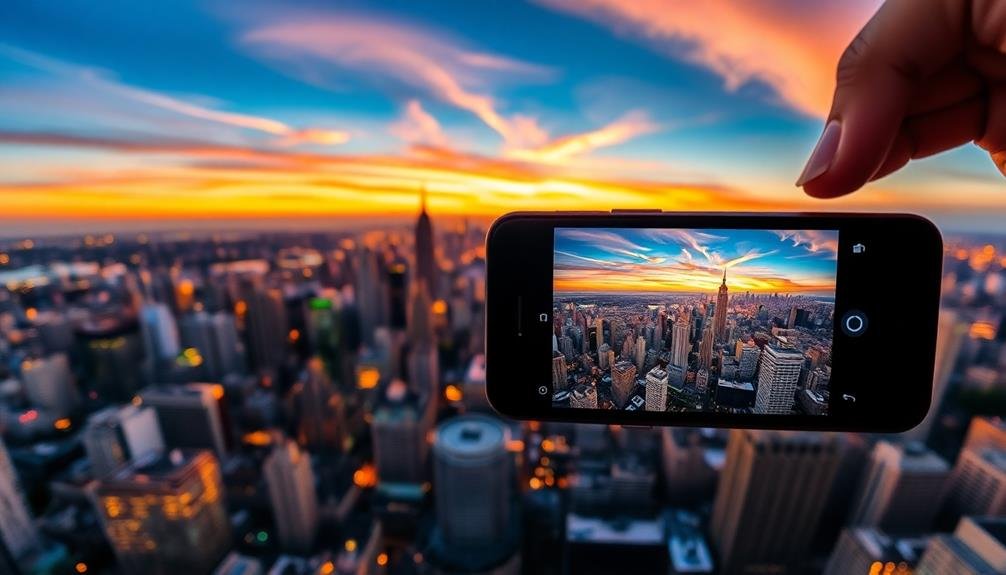Gigapixel panoramas are ultra-high-resolution images composed of billions of pixels, allowing you to zoom in on minute details without losing clarity. As a mobile user, you can create these immersive scenes using your smartphone's high-quality camera, panorama apps, and a steady hand or tripod. Capture images in a grid pattern with 30% overlap, maintaining consistent exposure and focus. Post-processing involves stitching the photos together and enhancing the final image. You can share your work through dedicated hosting services or by creating virtual tours. With the right techniques and equipment, you'll be on your way to producing stunning gigapixel panoramas that captivate viewers.
Understanding Gigapixel Panorama Technology
Three key components define gigapixel panorama technology: ultra-high resolution, seamless stitching, and interactive viewing.
When you create a gigapixel panorama, you're capturing an image with billions of pixels, far surpassing the resolution of standard digital photos. This extreme detail allows you to zoom in on minute elements without losing clarity.
Seamless stitching is essential for gigapixel panoramas. You'll need to take hundreds or even thousands of individual photos, which are then combined into a single, cohesive image.
Advanced software algorithms guarantee that these photos blend together smoothly, creating a panorama without visible seams or distortions.
Interactive viewing is the final piece of the puzzle. Gigapixel panoramas are too large to view in their entirety on a single screen.
Instead, you'll use specialized viewing software that lets you pan and zoom around the image, exploring different areas in detail. This interactivity transforms the viewing experience, allowing you to immerse yourself in the scene.
Understanding these components will help you appreciate the complexity of gigapixel panoramas and guide you in creating your own stunning, high-resolution images using your mobile device.
Essential Equipment for Mobile Users

Despite the advanced technology behind gigapixel panoramas, you don't need a lot of fancy equipment to create them on your mobile device. The essentials include a smartphone with a high-quality camera, a reliable panorama app, and a few accessories to enhance your shooting experience.
Your smartphone is the cornerstone of mobile gigapixel panorama creation. Most modern devices have cameras capable of capturing detailed images, but some perform better than others. Look for phones with high megapixel counts and advanced image processing capabilities.
To help you choose the right equipment, consider this comparison of essential items:
| Item | Purpose | Recommended Options |
|---|---|---|
| Smartphone | Image capture | iPhone 13 Pro, Google Pixel 6, Samsung Galaxy S21 Ultra |
| Panorama app | Image stitching | Google Street View, 360 Panorama, Panorama 360 |
| Tripod | Stability | Joby GorillaPod, Manfrotto PIXI Mini |
| Remote shutter | Reduce camera shake | Bluetooth remote, wired remote |
Don't forget to invest in a portable charger and extra storage. These will guarantee you can capture lengthy panoramas without interruption. With this essential equipment, you'll be well-prepared to create stunning gigapixel panoramas on your mobile device.
Capturing Gigapixel Images With Smartphones
Capturing gigapixel images with smartphones requires a combination of technique and patience. While your phone's camera may not match the resolution of professional equipment, you can still create impressive high-resolution panoramas with the right approach.
Start by selecting a suitable location with good lighting and minimal movement. Use a tripod or stabilizer to keep your phone steady throughout the process. Download a specialized panorama app that allows for manual control and stitching of multiple images.
Begin shooting in a grid pattern, overlapping each photo by about 30% to guarantee seamless stitching. Maintain consistent exposure and focus settings throughout the shoot. Take your time and be methodical, as rushing can lead to errors and gaps in your final image.
After capturing all the necessary frames, use your chosen app or desktop software to stitch the images together. This process may take some time, depending on the number of photos and your device's processing power.
Once complete, you'll have a gigapixel panorama that you can zoom into and explore in incredible detail, all captured with your smartphone.
Post-Processing Gigapixel Panoramas

Post-processing gigapixel panoramas is an essential step in creating stunning, high-resolution images. Once you've captured your individual shots, you'll need to stitch them together and refine the final product. Start by importing your images into specialized panorama software like PTGui, Hugin, or Adobe Lightroom's built-in panorama tool.
During the stitching process, pay attention to alignment and blending to guarantee seamless shifts between images. After stitching, focus on color correction, exposure balancing, and sharpening to enhance the overall quality of your gigapixel panorama.
Here's a quick guide to common post-processing steps:
| Step | Action | Purpose | Time | Difficulty |
|---|---|---|---|---|
| 1 | Import | Load images | 5min | Easy |
| 2 | Stitch | Combine shots | 30min | Medium |
| 3 | Align | Fix misalignments | 15min | Hard |
| 4 | Blend | Smooth shifts | 20min | Medium |
| 5 | Color | Correct and balance | 25min | Hard |
Remember to save your work frequently and export your final gigapixel panorama in a high-quality format suitable for your intended use, whether it's for print or digital display.
Sharing and Displaying Gigapixel Works
Once you've perfected your gigapixel panorama, it's time to showcase your work. Sharing these massive images requires careful consideration due to their size and complexity. Popular social media platforms often compress images, reducing the quality of your gigapixel work.
Instead, consider using dedicated image hosting services that support high-resolution files and deep zoom functionality.
For best viewing experiences, you can:
- Embed your panorama on a personal website using specialized viewers
- Create virtual tours with interactive hotspots and annotations
- Offer prints or wall-sized displays for physical exhibitions
- Develop mobile apps that allow users to explore your gigapixel images
When displaying your work online, make sure the viewer you choose supports smooth zooming and panning. Some popular options include Gigapan, Zoomify, and OpenSeadragon.
These tools allow viewers to appreciate the intricate details of your panorama without sacrificing performance.
For in-person exhibitions, consider large-format printing or projection mapping. These methods can create immersive experiences that truly showcase the scale and detail of your gigapixel panorama.
Remember to provide information about the capture process and equipment used, as this often intrigues viewers and adds value to your presentation.
Frequently Asked Questions
How Much Storage Space Does a Typical Gigapixel Panorama Require?
You'll need considerable storage for a typical gigapixel panorama. It can require several gigabytes, often ranging from 2GB to 10GB or more. Be prepared to allocate significant space on your device or external storage.
Can Gigapixel Panoramas Be Viewed on Standard Mobile Devices?
Yes, you can view gigapixel panoramas on your standard mobile device. They're often accessible through specialized apps or mobile-friendly websites. However, you'll need a strong internet connection and may experience slower loading times due to their large size.
Are There Any Privacy Concerns When Capturing Gigapixel Panoramas in Public Spaces?
Yes, there are privacy concerns when capturing gigapixel panoramas in public spaces. You'll need to be aware of people's rights to privacy and avoid capturing identifiable individuals without consent. Always follow local laws and regulations.
How Long Does It Typically Take to Capture a Gigapixel Panorama?
You'll find capturing a gigapixel panorama can take anywhere from 30 minutes to several hours. It depends on your equipment, skill level, and the scene's complexity. Don't rush; patience is key for stunning results.
Are There Any Legal Restrictions on Creating or Sharing Gigapixel Panoramas?
You'll need to be aware of privacy laws and copyright restrictions when creating and sharing gigapixel panoramas. Always get permission for private property and recognizable individuals. Public spaces are generally okay, but check local regulations to be safe.
In Summary
You've now got the tools to create stunning gigapixel panoramas with your smartphone. Remember, practice makes perfect. Don't be afraid to experiment with different techniques and apps. As you refine your skills, you'll capture increasingly impressive ultra-high-resolution images. Share your creations online and watch as viewers zoom in to explore the intricate details. With patience and creativity, you'll soon be producing professional-quality gigapixel panoramas that'll wow your audience.





Leave a Reply